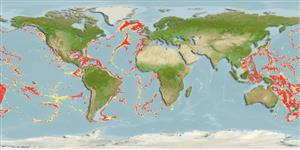>
Ophidiiformes (Cusk eels) >
Ophidiidae (Cusk-eels) > Neobythitinae
Etymology: Xyelacyba: Greek, xyele, -es = plane (tool) + Greek, kybeia, -ou = a fish (Ref. 45335).
More on author: Cohen.
Environment: milieu / climate zone / depth range / distribution range
Ecología
marino batidemersal; rango de profundidad 984 - 2500 m (Ref. 34024). Deep-water
Possibly worldwide in tropical and subtropical seas (but not yet caught in the eastern Pacific) (Ref. 34024). Eastern Atlantic: 2 specimens between 12°N and 9°25'N. Western Atlantic: Gulf of Mexico to off southern Brazil. Northwest Pacific: Ashizuri Cape, Japan.
Tamaño / Peso / Age
Maturity: Lm ? range ? - ? cm
Max length : 57.0 cm TL macho / no sexado; (Ref. 3686)
Short description
Claves de identificación | Morfología | Morfometría
Radios blandos dorsales (total) : 89; Radios blandos anales: 74. Body and tail strongly compressed, snout round and short, no spine on tip. Head and body uniformly whitish, margins of median fins light brown, jaws, pelvic fins, mouth and gill cavities deep brown. Peritoneum and stomach deep brown, intestine yellowish.
A benthopelagic species at bathyal depth (Ref. 56809). Found on the continental slope (Ref. 75154). Rare species (Ref. 34024). Reproductive strategy possibly similar to other members of this family featuring oviparity, with oval pelagic eggs floating in a gelatinous mass (Ref. 205).
Life cycle and mating behavior
Maturities | Reproducción | Spawnings | Egg(s) | Fecundities | Larva
Nielsen, J.G., D.M. Cohen, D.F. Markle and C.R. Robins, 1999. Ophidiiform fishes of the world (Order Ophidiiformes). An annotated and illustrated catalogue of pearlfishes, cusk-eels, brotulas and other ophidiiform fishes known to date. FAO Fish. Synop. 125(18):178p. Rome: FAO. (Ref. 34024)
IUCN Red List Status (Ref. 130435)
Threat to humans
Harmless
Human uses
Pesquerías: sin interés
Herramientas
Special reports
Download XML
Fuentes de Internet
Estimates based on models
Preferred temperature (Ref.
123201): 2.5 - 5.2, mean 3.5 °C (based on 1299 cells).
Phylogenetic diversity index (Ref.
82804): PD
50 = 1.0000 [Uniqueness, from 0.5 = low to 2.0 = high].
Bayesian length-weight: a=0.01122 (0.00514 - 0.02450), b=3.04 (2.87 - 3.21), in cm total length, based on all LWR estimates for this body shape (Ref.
93245).
Nivel trófico (Ref.
69278): 3.7 ±0.6 se; based on size and trophs of closest relatives
Resiliencia (Ref.
120179): Medio, población duplicada en un tiempo mínimo de 1.4-4.4 años (Preliminary K or Fecundity.).
Fishing Vulnerability (Ref.
59153): Moderate vulnerability (43 of 100).
